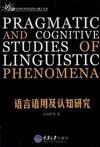语言语用及认知研究
2007-9
重庆大学出版社
刘国辉
284
正如维特根斯坦所言,语言是一种“游戏”,但这种“游戏”背后是有隐含规则或规律的,这就需要去认真探讨和研究。《求索外语学术研究系列·博士文库:语言语用及认知研究》从语用、认知视角对一些语言现象,如英汉请求回应、英汉中动结构、英汉名词性领属结构、“Ulysses”象似性和英汉时间隐喻进行了多角度考察。该研究对语言研究者或爱好者有较高的学术参考价值与实用价值。
刘国辉,重庆大学外国语学院教授(博士),副院长,重庆市语言认知及语言应用研究基地专职研究员,研究生导师.副博导,重庆市外文学会理事,中国认知语言学会常务理事,中国高校功能语言学会理事,重庆大学民車主委。2003年6月毕业于复旦大学外文学院,获文学博士学位。主要从事理论语言学研究。近年来已在《外语教学与研究》和《外国语》等专业学术刊物上公开发表学术论文近40篇,出版学术专著4部,其中《当代语言理论与实践探索》(1999),2001年获四川有政府三等奖,《英汉请求策略理论与买证对比研究——礼貌语用学视野》(2007)获专家好评。2005年获得重庆市高等学校优秀中青年骨干教师第二批资助计划,2006年被评为重庆大学“优秀教师”。
Chapter One A Contrastive Study of Responses to Requests in English and Chinese1.1 Introduction1.2 Subjects1.3 The Questionnaire1.4 Instrument——The Discourse Completion Test1.5 Quantitative Findings Concerning Request Responses among Americans and the Chinese People1.6 Contextual Variables in the Responses to Requests1.7 Tentative Analysis of the Common Features of Request Responses1.8 Limitations and Further Research1.9 ConclusionsChapter Two Middle Construction in English and Chinese:A Cognitive Semantic Study2.1 Introduction2.1.1 Orientation and Motivation of the Study2.1.2 The Concept of Middle Construction2.1.3 Aims and Hypotheses of the Study2.1.4 Layout and Scope of the Study2.2 Literature Review2.2.1 Middle Construction2.2.2 Construction Grammar2.3 Middle Construction in English2.3.1 Classification of Middle Construction in English2.3.2 Characteristics of Middle Construction in English2.4 Middle Construction in Chinese2.4.1 Middle Construction in Chinese2.4.2 The Classification of Chinese Middle Construction2.4.3 The Characteristics of Chinese Middle Construction2.4.4 The Selectional Restriction of Middle Verbs in Chinese2.4.5 Particularity of Chinese Middle Construction2.5 Conclusions2.5.1 Findings of the Study2.5.2 Limitations of the Study2.5.3 Suggestions for Further ResearchChapter Three A Comparison of Nominal Possessives in English and Chinese from a Cognitive Perspective3.1 Introduction3.1.1 Orientation of the Title3.1.2 The Significancc of the Present Study3.1.3 Methods3.1.4 The Aims of the Present Study3.1.5 Layout and Scope of the Study3.2 Literature Review3.2.1 Traditional Grammar3.2.2 Transformational and Generative Grammar3.2.3 Cognitive Linguistics3.3 Concepts of Possession3.3.1 Definition of Possession3.3.2 Classification of Possession3.3.3 Possessive Morphemes3.4 A Cognitive Approach3.4.1 Possessor as Reference Point3.4.2 Possessor Specification and Possessee Specification3.4.3 Possessive Prototypes3.4.4 From Iconicity to Possessive Constructions3.5 ConclusionsChapter Four Ieonieity in Ulysses4.1 Introduction4.1.1 Motivation of the Present Study4.1.2 The Concept and Criteria of Iconicity4.1.3 The Nature of the Study and Iconicity4.1.4 Methods4.1.5 The Aims and Hypotheses of the Present Study4.1.6 Layout and Scope of the Study4.2 Literature Review4.2.1 Introduction4.2.2 Iconicity Studies in Language4.2.3 Literature Review of the Stream of Consciousness Novel Studies4.2.4 Summary4.3 The Application of Iconicity in Ulysses4.3.1 Introduction4.3.2 From the Phonological View4.3.3 From the Morphological View4.3.4 From the Syntactic View4.3.5 From the Textual View4.4 Contrastive Analysis4.4.1 The Differences and Similarities of Iconicity between Ulysses and Other Streams of Consciousness Novels in Western Culture4.4.2 The Differences and Similarities of Iconicity Studies in the Stream of Consciousness Novels between Western and Eastern Culture4.5 Conclusions4.5.1 Findings4.5.2 Limitations of the Study4.5.3 Suggestions for Further Studies in This FieldChapter Five A Cognitive Approach to Temporal Metaphors in English and Chinese5.1 Introduction5.1.1 The Basic Concepts5.1.2 Orientation of the Title5.1.3 Motivations of the Study5.1.4 The Aims and Hypotheses of the Present Study5.1.5 Basic Approaches to the Present Study5.1.6 Layout and Scope of the Study5.1.7 Summary5.2 Literature Review5.2.1 Literature Review of Metaphor Studies in the West and China5.2.2 Theoretical Background of Temporal Metaphor5.2.3 Literature Review of Temporal Metaphor Studies in English and Chinese5.2.4 Summary5.3 A Contrastive Study of Temporal Metaphors in English and Chinese5.3.1 Classification of Temporal Metaphors5.3.2 Similarities between Temporal Metaphors in English and Chinese5.3.3 Motivations for the Similarities Between Temporal Metaphors in English and Chinese5.3.4 Differences Between Temporal Metaphors in English and Chinese5.3.5 Motivations for the Differences BetweenTemporal Metaphors in English and Chinese5.3.6 Special Temporal Metaphors in Chinese5.3.7 Summary5.4 The Application of the Present Study to Foreign Language Teaching5.4.1 Guides for Foreign Language Teaching5.4.2 Contrastive Study for Foreign Language Teaching5.5 Conclusions5.5.1 Major Findings5.5.2 Speculations about the Future Studies of Temporal MetaphorsReferences
